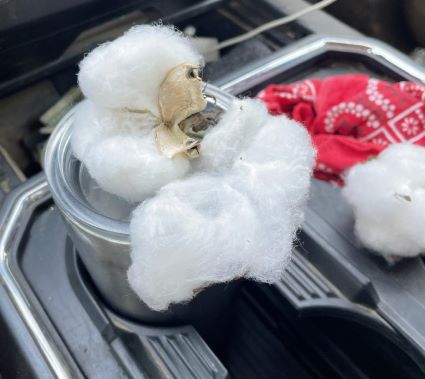Crop Scan Ag Report: Focus on Final Pre-Harvest Management
Water seems to be top of mind across the Cotton Belt. Some areas could still use a few inches to help catch up after the recent heat wave. And in areas where bolls are starting to open, a little rain may do more harm than good. Growers are still managing insect treatments in the Southeast and West Texas, and defoliation is not far off in other areas.
Here’s what our contributing consultants are saying:
Chad Harrell owns and operates Harrell Agronomic Services in Northeastern North Carolina.
Cotton in our region has changed a lot since the last update.
We have seen extreme heat and very spotty rains over the past couple of weeks. Our cotton is now at the sixth-to-seventh week of bloom and has cut out rapidly over the last week. Much of our top crop has aborted this year due to lack of moisture and high temperatures, although we still have a good boll load throughout the plant.
Insect pressure has tapered off as corn and other hosts have dried down. The 3-gene cotton seems to be holding well this year as we have seen a somewhat light moth flight. Most of the cotton will be safe from insects this week, except for a few later planted acres.
I think we still have decent yield potential this year if we can get just a little more moisture to finish these bolls out.
Wes Briggs consults on cotton, corn, peanuts, soybeans, and small grains for growers in Georgia, Alabama, and Florida.
We still have a long way to go in South Georgia. With our long growing season, we’re still running wide open. We have a lot of late planted crop this year, so we’ll still be applying PGRs, water and insect sprays on through September.
We have some areas around here that caught maybe an inch of rain over the past eight weeks. We have dryland cotton that has completed shed everything in the top third of the plant and is open at the bottom. Dryland acres are going to be mediocre, especially anything planted in May. It’s not going to be great cotton for us, probably less than a bale. April planted cotton looks a little but nothing really great.
We continue to spray for spider mites. We also have some whiteflies that are increasing weekly, and a little rain off of this storm may beat them back a little. I do expect we’ll have to spray for whiteflies in our younger cotton that still has a ways to go.
Plant bugs have resurfaced. We have some fields where we haven’t had to treat for stink bugs in more than two weeks, and plant bugs are moving it. We’re addressing them and stink bugs at the same time.
We have a lot of irrigated cotton that’s one to three nodes above white flower. We have a decent amount of cotton going into open boll. After we see what happens with the storm, we’ll start cutting back on water on this older cotton.
Overall, we shed a lot of fruit this year due to the heat. If we can hang on to this bottom crop and can get it open without a lot of rainfall, I’ll still feel good about a lot of our cotton. It’s definitely not the crop we had last year, but we’ll have a decent amount of 1,300-1,400-pound cotton if we can get it open.
It’s been a struggle to keep up with irrigation. We’ve had to make this crop predominately with irrigation this summer without a lot of rainfall. Pivots are made to supplement rainfall, not to make a crop. But that’s essentially what we’ve had to do so far.
Probably the worst thing that could happen now – as bad as we need rain – would be to start getting rains 3-4 times during the week. I wish we could get a couple of inches of rain, then have it move out and be gone. Two inches would catch us up a lot.
Tucker Miller is a Mississippi-based independent private consultant for cotton, soybeans, corn, peanuts, rice, and vegetables.
Our cotton is maturing rapidly with all the heat we have had the last three weeks. We did get a rain on Sunday which will help fill out some top bolls in the late cotton. We watered a lot of our cotton last week , which we don’t normally do in late August. Our early May planted cotton is finished blooming and is starting to open now.
We are finished with all insect control measures and will be looking at defoliation on some fields in a week or ten days. Most of our cotton is two to three weeks out from defoliation.
 8 seed per lock, 5-lock boll (Tucker Miller)
8 seed per lock, 5-lock boll (Tucker Miller)
It appears like we have an excellent crop and will hope for good harvest weather from now on out.
Mark Nemec is an independent agricultural consultant for cotton, wheat, grain sorghum and corn in the Blacklands and Brazos River Bottom area of Central Texas.
It’s just about over in Central Texas. The hot summer has cooked the dryland cotton. Defoliation has started, and some fields have even been stripped already. Yields are disappointing on much of it.
Irrigated cotton still looks promising in the Brazos Valley. We turned the water off the last few weeks. The heat has the bolls popping like popcorn as the crop is maturing rapidly. Defoliation should start on some of it in the next week or so.
I thought the weatherman said that El Niño meant cooler and wetter weather for Texas?
Kerry Siders is Texas A&M AgriLife Extension Agent-IPM for Hockley, Cochran, and Lamb Counties.
Cotton is mostly all hard cut-out (fewer than 2 nodes above white flower) with only an occasional bloom in the top node. I anticipate seeing cracked bolls before the end of August.
Watering is still the big question for most. Unless you have good size bolls all the way to the top, it would be highly recommended to continue to water at least till the end of August. For some who can irrigate in September, remember that the bolls you want to harvest should not undergo water stress until they are 20 days old. So, if you set your last harvestable bolls on or around Aug. 15, I would stay with irrigation until that first full week of September. After that point, the crop can take moderate stress, wilt in the heat of day, and fully recover by next morning. Once those youngest bolls are 40-45 days old, then it can withstand more severe water stress.
Insect pests in cotton mainly consist of an occasional cotton aphid, a few scattered bollworms in conventional cotton, and some lingering plant bugs. Beneficial insects seem to be staying on top of the aphids. The bollworms are having a hard time doing anything in this heat, as most worm pressure has been drawn towards corn and milo. And plant bug numbers are just not there. So, keep an eye out for at least another week or so, but most acres are nearly out of the woods in terms of being vulnerable to pest damage.
If you are still irrigating and or receive future rain, I would highly encourage you to sample suspect fields for cotton root-knot nematodes. Sampling is much easier and better when you have good soil moisture.
Photo: Kerry Siders
















